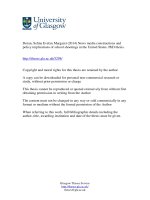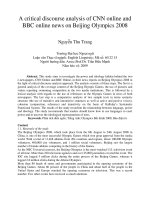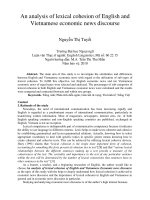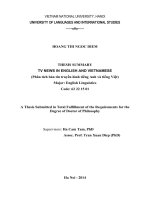News-gathering-and-visuals
Bạn đang xem bản rút gọn của tài liệu. Xem và tải ngay bản đầy đủ của tài liệu tại đây (110.64 KB, 10 trang )
UNIT 2.6:
NEWS GATHERING AND
VISUALS
1. GATHERING NEWS
The four most commonly used methods in news gathering used by journalists are
observation, telephone conversations, research and interviews.
OBSERVATION
Observation consists of your actually seeing an event take place and then reporting what
you have seen in the form of a news story. The difference between a good story and a
poor one is often in the skill of the observer. Skilled observers use their eyes, ears, mind,
notebooks and tape recorders. They make sure they get the concrete facts, specific figures
and accurate information. They look for the colorful, the dramatic or the unusual in any
situation.
Skilled observers always try to get more information than they actually need. They know
it is easier to discard excess material than to retrace their steps after the story is cold.
Developing your powers of observation can come only through experience. You cannot
become a skilled observer by simply reading a book. The key to becoming a good
observer is to look for more than you see on the surface.
(McKane, 2013; Rich, 2015)
RESEARCH
Research is nothing more than digging out information from files and reference works.
Research is used to verify or amplify facts in news stories and to give depth to feature
stories and magazine articles.
To do any extensive research, learn to use the facilities of the public or college library.
Here you can find the necessary books, encyclopedias, almanacs, magazines, atlases,
directories, indexes and similar References (Sloan et al., 2002).
INTERVIEWS
About 90 percent of everything in a news story is based on some form of interviewing either in person, by telephone, or occasionally, by correspondence.
As a journalist in search of information, you must learn who to get information from and
how to record facts. You must learn techniques for handling different kinds of people how to draw some out, how to keep others on the topic and how to evaluate the motives
or honesty of others. In short, you must learn how to get along with people and how to
treat them with tact and understanding while still accomplishing your purpose.
Types of Interviews
A distinction must be made between news stories that are merely based on interviews and
actual interview stories. Very seldom is a journalist present at the scene of an accident as
it takes place - for example, at a collision between two automobiles. A story of this type
must be based entirely on interviews - either in person or by telephone - with the police,
with eyewitnesses, with the victims themselves, and depending upon the gravity of the
accident, with the garage mechanics, hospital attendants, relatives of the victims and
others.
Interviews are as varied as the people who grant them, the journalists who conduct them
and the news that suggests them. Rarely are interviews so mechanical that they can be
reduced to standard formulas or categories. Several types, however, deserve special
attention because they are the ones that occur most frequently. They are as follows:
News interview: The news interview is based on "hard news," some event or
development of current and immediate interest
Telephone interview: The telephone interview, a modified version of the news
interview, has a number of obvious advantages, and at the same time, it has several
limitations that challenge a resourceful journalist. Ingenuity and clear thinking are
sometimes needed to locate a news source when a big story breaks; the power of
persuasion is often necessary to elicit information from a reluctant person who can
easily hang up the receiver, and a sympathetic telephone voice is important when
you are talking to a family where tragedy has struck.
Telephone conversations may range from full-scale interviews to brief queries to
verify or amplify information. But regardless of how often you use this method of
news gathering, you should keep the following points in mind:
Know what information you want before you dial. Keep your pencil and paper
handy. Do not call someone and then ask that person to wait while you look for
writing materials.
Speak politely indistinct, well-modulated tones.
Be cheerful and businesslike.
Make sure you get your facts straight. Ask the other person to repeat figures or
spell out names.
Avoid three-way conversations among yourself, the person on the telephone
and somebody else in your office.
Recheck your information by reading it back to the person who has given it to
you.
Record the conversation using a "telephone pick-up" (a device that attaches to
the telephone receiver and plugs into the microphone jack of the cassette tap
recorder). Be sure to inform the person on the other end that you are recording
the conversation for note-taking purposes only.
Do not discuss classified information.
Although a telephone is a very useful instrument, remember it is not the only, and
not necessarily the best, method of gathering news. It should supplement, but not
replace, all other methods. Whenever it is proper and convenient, use the
telephone, but do not be afraid to engage in a little legwork.
Casual interview: An accidental encounter between a journalist and a news source
on the street or at a social gathering can often result in a tip that arouses the
curiosity of a writer. A major news story may be the result after you do some
digging.
Personality interview: In the personality interview an effort is made to let the
reader see the appearance, mannerisms, background and even the character of the
subject. Magazines like the New Yorker have developed this type of interview,
called "a profile," into a high art not easily attained by daily newspapers under the
pressure of deadlines. However, with preliminary research on an interviewee's
background, intelligent planning of questions and skillful interviewing, a good
journalist can let a person's words and mannerisms bring that individual vividly to
life in an interesting newspaper feature story.
Symposium interview: From time to time, news developments of current interest
require a journalist or a team of journalists to seek information not from one or
two sources but from a dozen, or perhaps a hundred or more. For example, which
of the two presidential candidates in the television debate made the best
impression on the public? How do the residents of a city feel about their football
team winning the Super Bowl? For some stories - as in a pre-election poll - all of
the techniques of a scientific opinion sampling may be required. In other instances,
reactions and comments may result in a lively feature story. Depending on the
subject, the symposium (or group) interview may bring out opinions of
importance, entertainment or merely the views of the "man on the street" on some
subject of general interest.
(Sloan et al., 2002; Integrate, n.d; Whitaker et al., 2013)
Interview Questions
Good interviews need good planning, so remember closed-ended questions and openended question when preparing your questions. Closed-ended questions often prompt the
short response "Yes" or "No". Open questions are usually preferred by journalists because
they encourage people to give more information. Open questions are also known as 'W'
questions because they usually begin with What, Who, Where, When, Why - and How.
Another top tip which will make life a lot easier when it comes to editing your
material is to try to get your interviewee to include the question in their answer.
Get as much background information as well before you set off for an interview so
you can ask the right questions.
Often when journalists put together a report, the interviewer's questions are edited
out - to save time and to make the report seem more natural.
Example:
Imagine the difference between hearing: "They're great, apart from we only have chips
on Friday!" and "I think school dinners are great, except that we only have chips on
Friday!" The second answer tells you everything, whereas the first one leaves you
wondering.
(Sloan et al., 2002)
2. THE IMPORTANCE OF VISUALS
The presentation of a story with photographs or graphics is crucial. The Eye Track study
showed that readers are drawn to color photographs first, then headlines, cutlines
(captions).
Pictures were mostly taken for the action and content rather than any aesthetic
consideration. Today, they are used in the newspapers for different reasons.
Photographs in Journalism inform, educate and enlighten readers about current issues and
also reflect on the past as well. Photographs in Newspaper enhance the credibility of the
stories. As they depict reality, they also furnish evidence to show the authenticity of a
news story or give proof of an event that occurred.
Its aesthetic values enable a photograph to serve as a tool to attract reader’s attention and
break the monotony of news content. Thus, photographs enhance and beautify the pages
of a newspaper.
A photograph in Newspaper speaks more than a thousand words. No formal education is
required to understand a picture. Photographs are therefore able to break through literacy
barrier to effectively communicate a message. It is a universal language.
(Rich, 2015; Sloan et al., 2002)
PRACTICAL EXERCISES
Exercise 1: Open and closed questions
Work in pairs. A asks B the following questions:
1. Do you like school?
2. Do you meet your friends during break?
3. Is homework set every day?
4. Do you eat school dinners?
Pick a topic to interview each other about. Take it in turns to ask each other as
many open questions as you can in a minute.
Under pressure, it's not always easy to avoid closed questions!
5. What do you like about school?
6. What do you do during break-time?
7. How much homework do you receive?
8. What do you think of school dinners?
Exercise 2: Write a news story
Write a news story based on the following interview with a bookkeeper at the
North Point Inn. “Q” stands for the questions she was asked during an interview
at her home this morning, and “A” stands for her answers, which can be quoted
directly. (The interview is based on an actual case: a robbery and murder at an
elegant restaurant.)
Q: Could you start by spelling your name for me?
A: N-i-n-a C-o-r-t-e-z.
Q: You work as a bookkeeper at the North Point Inn?
A: Yes, I’ve been there seven years.
Q: Would you describe the robbery there yesterday?
A: It was about 9 in the morning, around 7 or 8 minutes before 9.
Q: Is that the time you usually get there?
A: At 9 o’clock, yes.
Q: How did you get in?
A: I’ve got a key to the employee entrance in the back.
Q: Was anyone else there?
A: Kevin Blohm, one of the cooks. He usually starts at 8. We open for lunch at 11:30,
and he’s in charge.
Q: Did you talk to him?
A: He came into my office, and we chatted about what happened in the restaurant the
night before, and I asked him to make me some coffee. After he brought me a cup, I
walked out to the corridor with him. That was the last I saw him.
Q: What did you do next?
A: I was just beginning to go through the receipts and cash from the previous night. I
always start by counting the previous day’s revenue. I took everything out of a safe,
the cash and receipts, and began to count them on my desk.
Q: About how much did you have?
A: $6,000 counting everything, the cash and receipts from credit cards.
Q: Is that when you were robbed?
A: A minute or two or less, a man came around the corner, carrying a knife.
Q: What did you do?
A: I started screaming and kicking. My chair was on rollers, and when I started kicking, it
fell. I fell on the floor, and he reached across my desk and grabbed $130 in $5 bills.
Q: Did he say anything?
A: No, he just took the money and walked out.
Q: Was he alone?
A: I don’t think so. I heard someone—a man—say, “Get that money out of there.” Then
someone tried to open the door to my office, but I’d locked it. Three or four minutes
later, the police were there.
Q: Is that when you found Mr. Blohm?
A: I went into the hallway with the police and saw blood on a door in the reception area.
It was awful. There was blood on the walls and floor. Kevin was lying on the floor,
dead. He had a large knife wound in his chest and another on one hand.
Q: Can you describe the man who robbed you?
A: He was about 5 feet 10, maybe 6 feet tall, in his early 20s, medium build.
Q: What was he wearing?
A: Blue jeans, a blue plaid button-up shirt and blue tennis shoes.
Q: Did you see his face?
A: He had a scarf, a floral scarf, tied around the lower part of his face, cowboy style. It
covered the bottom half of his face.
Q: Did the man look at all familiar, like anyone you may have known or seen in the
restaurant?
A: No.
Q: Did you notice anything unusual that day?
A: I saw a car in the parking lot when I came in, one I didn’t recognize. It didn’t belong
to anyone who worked there, but that’s all I remember.
Q: Do you have any idea why someone stabbed Blohm?
A: No. Kevin might have gotten in his way or tried to stop him or recognized him or
something. I don’t know. I didn’t see it. I don’t know anything else.
…………………………………………………………………………………
…………………………………………………………………………………
…………………………………………………………………………………
…………………………………………………………………………………
…………………………………………………………………………………
…………………………………………………………………………………
…………………………………………………………………………………
…………………………………………………………………………………
…………………………………………………………………………………
…………………………………………………………………………………
…………………………………………………………………………………
…………………………………………………………………………………
…………………………………………………………………………………
…………………………………………………………………………………
…………………………………………………………………………………
…………………………………………………………………………………
…………………………………………………………………………………
…………………………………………………………………………………
…………………………………………………………………………………
…………………………………………………………………………………
…………………………………………………………………………………
…………………………………………………………………………………
…………………………………………………………………………………
…………………………………………………………………………………
…………………………………………………………………………………
…………………………………………………………………………………
…………………………………………………………………………………
…………………………………………………………………………………
…………………………………………………………………………………
…………………………………………………………………………………
…………………………………………………………………………………
…………………………………………………………………………………
…………………………………………………………………………………
…………………………………………………………………………………
…………………………………………………………………………………
…………………………………………………………………………………
…………………………………………………………………………………
…………………………………………………………………………………
Exercise 3: Research and writing questions.
Imagine your editor has asked you to do some background research about your local MP
or a sports person of your choosing in preparation for an interview. Spend 20 minutes
looking online for information.
Based on the information you have found, compose five open questions for your local MP
or sports person. They should add to the background research you have just done, not
give you the same answers.
Rank the questions in the order you would ask them. Remember, you may not have
enough time to ask them all, and that it will often put your guest at ease to start with an
easier question.









